In this post I will analyze the most common succulent plants, and whether they are safe for your pets, such as dogs, cats, rabbits, etc. Enjoy!
Is Aloe Vera poisonous to cats?
It is one of the paradoxes of nature that substances we use as a cure (in smaller amounts) can often poison us in larger amounts. Aloe Vera is a famous medicinal plant, and many of us grow it at home. What many people do not know though, is that Aloe is toxic to cats, and can cause them issues ranging from lethargy and loss of appetite to serious diarrhea, vomiting and abdominal cramps. But there are also a lot of myths surrounding cats and aloes, such as cats are attracted to these plants, and you should not grow them at home when you have a cat. Nothing can be further from the truth.
Before we look at the facts & myths, let me clarify why Aloe Vera is toxic to cats. Raw Aloe–that means the plant you have at home, not some product you get in a shop–contains anthracene, glycosides, and anthraquinones, substances that can cause significant irritation to GI tract of both humans and cats. Hence if your cat eats some Aloe, it will likely experience the symptoms of food poisoning, such as stomach cramps, diarrhea, and vomiting. The severity of the symptoms depends on two factors: the amount of Aloe consumed, and the individual predispositions of a cat. Just like each human being has unique gut flora and stomach, so has each cat. Some cats may show no reaction whatsoever (or only a very mild one) to a contact with Aloe, others may develop serious symptoms even when they eat just a small part of the plant.
Cats aren’t attracted to Aloe plants, and won’t eat them in normal circumstances
Cats are intelligent animals, and their instincts rarely betray them. In normal circumstances, they won’t go and eat things that can harm them, such as Aloe Plant. Normal circumstances mean that your feed your cat well, it doesn’t experience stomach discomfort due to parasites (cats seek plants of any kind when having parasites in their gut), and has some points of interest in the house, such as balls of wool, toys, other animals it can play with.
Cats won’t just go and eat Aloe for no reason. They are obligate carnivores, they will not take interest in the Aloe unless there’s something wrong, or they are bored and find the plant the most interesting thing in the room/house. I just wanted to write this to make sure we bust the myth that cats are attracted to toxic plants like Aloe and you should not have the two in the same room. Because that’s just no true. Aloe Vera is an amazing succulent, and having a cat should not stop you from growing it.
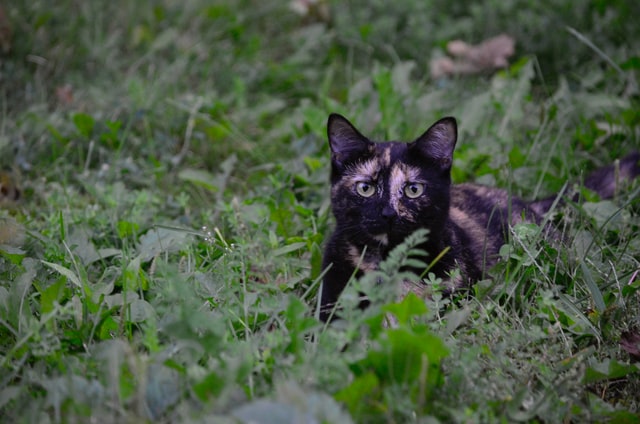
Symptoms of poisoning from Aloe typically manifest quickly
Just like any other irritation of GI tract, poisoning with Aloe will show itself pretty much within hours of the incident of your cat eating the plant. As I’ve already written, the severity of the response depends on the quantity it ingested, as well as the individual GI health and overall health of the cat in question. Some cats may vomit once, some repeatedly, some may show other symptoms such as diarrhea or simply showing discomfort and acting abnormally.
It is important to know this, since some people mistakenly blame Aloe for problems of their cat. What I try to say here is that if you saw your cat taking one small bite of your Aloe on Monday, and it starts cramping and vomiting on Friday, you should look elsewhere for the reasons of the problem. Also if your cat barely touched the plant with its tail, it’s not going to experience the GI tract issues.
Just like with other GI problems, vet will only treat the symptoms–but you should still visit them if the symptoms are severe
There’s no magical cure to Aloe Vera poisoning in cats. Vet cannot give your cat some magical pill or injection that will somehow neutralize the toxins from Aloe. Once the GI tract has been irritated and the cat experiences symptoms, the treatment is focused on addressing the symptoms, and making sure your cat does not suffer some worse problem in a chain of cause and effect, such as a serious dehydration.
As a rule of a thumb, if you are not sure, you should always visit the vet. They’re the professional, know your cat (and its medical history), and can suggest the remedies you should take. Many times they will simply recommend a bland diet, that means foods that cause minimal irritation to GI tract of your cat, to not further aggravate the issue. The symptoms will eventually subside, and the cat will feel good again.
Precautions you can take to minimize the chances of your cat getting poisoned with Aloe Vera
In my experience with animals, the best thing you can do is to make sure your cat has no reason to hang around your Aloe Plant. You can do a few things here: Make sure it is well fed, and always have some points of interest, some things it can play with–balls of wood, toys for cats, or you :).
Secondly, it is good to have some grass ready, either in a bowl or in a glass with water always. Just as we humans experience GI discomfort sometimes so do cats. Their reaction is eating something green, ideally grass. But if there’s no grass and no plant they find more attractive in the house, if the only plant in their reach is Aloe Vera, you cannot wonder they take a bite from it.
Last but not least, you can try to place your Aloe in a spot that your cat cannot reach easily. Of course a healthy can with good body weight can jump almost anywhere, so it is naive thinking that placing your Aloe on a table one meter high will prevent the cat from reaching it. If you hang the pot from the roof, however, or place your Aloe in a room that’s locked when you’re not at home and a cat cannot get inside, you should be good to go.
Final thoughts
Aloe Vera is poisonous to cats, but it should not discourage you from growing this beautiful succulent. As long as you take the precautions I just mentioned, the chances of your cat poisoning with Aloe are super slim. Even if it ingests part of the plant, the symptoms should not bother it for too long, and you can always consult the vet to help address them. Thank you for reading, and good luck with both your pets and plants!
* Disclaimer: The content on this page is for general information purposes only. We are pet and plant lovers (and have real life experience with cats and succulents), but we aren’t medical professionals. Hence we make no representations or warranties of any kind, express or implied, about the completeness, accuracy, reliability, suitability or availability with respect to the information contained on this website for any purpose. Any reliance you place on such information is therefore strictly at your own risk. If you aren’t sure, contact a vet or other professional. \
Is Kalanchoe poisonous to cats, and dogs?
Pet lovers are often also plant lovers. What can be better than seeing a lovely satisfied cat walking around your house, softly, among many wonderful plants with colorful flowers, such as Kalanchoe? Cats also like nature, and they prefer to live in a place with plant and trees, somehow imitating their natural habitat. The only problem is that some plants are toxic, and if ingested by cats, they can cause them problems. But what about Kalanchoe (Flaming Katy), one of the favorite succulents in the US and Europe? Is it poisonous to cats, and should you be worried?
Let me start with a quick answer: Kalanchoe is poisonous to cats, but it isn’t deadly. Just like with many other issues, though, a short answer isn’t really enough to explain all the nuances of the peculiar relationship of animals and plants. Many other questions come into mind: Do cats eat Kalanchoe, and why? In what quantities is it poisonous, and what problems can can it cause? And what precautions should you take? I will try to answer all your questions on the following lines.
Do cats eat Kalanchoe, and if they do, why?
As a rule of thumb, cats are obligate carnivores, and they do not eat plants, at least not in quantities. However, as every cat lover knows, a cat may sometimes eat grass, some flower, or a random plant. This phenomenon isn’t scientifically explained yet, though different theories do exist, ranging from simply imitating the behavior of their wild ancestors to being attracted by certain colors and scents in the plants.
Theory is one thing, practice another though. I’ve been a pet lover for years, and can confirm that this behavior really depends on the character of each individual cat, or dog. Some pets never eat plants, while others will take a bite almost daily. And I am confident to say that the same applies to Kalanchoes. What I try to say here is that if you basically never see your cat eating plants, the chances are high it won’t take any interest in your colorful Kalanchoes. On the contrary, if your beloved pet devours grass and plants in your garden almost on a daily basis, you need to be more careful when it comes to the toxicity of the plants.
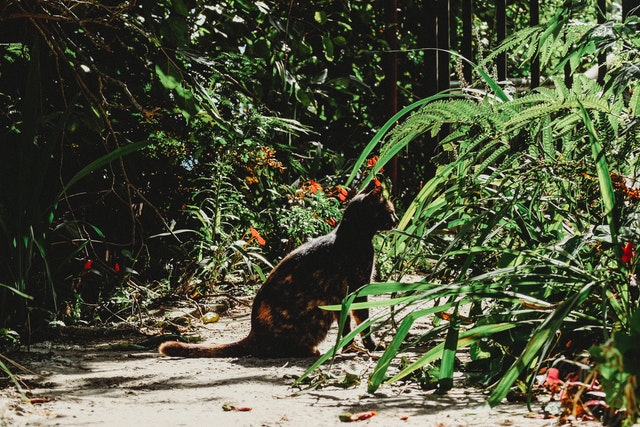
What quantity of Kalanchoe is poisonous to cats?
People generally underestimate the instincts of their animals. Animals often eat strange things, especially when you take them to the nature with you, but they almost always know why. You should also remember that many poisons are used as a cure in medicine, in little quantities. Dogs and cats may take a bite of different things in the wild, trying to address certain discomfort in their stomach, or other issue they face. They do it instinctively and their instincts are rarely wrong. Hence if your cat eats one flower of Kalanchoe (or any other plant) at random, in my opinion it isn’t really a reason to worry…
Kalanchoe contains cardiac toxins (bufadienolides), but ingestion by dogs and cats most often results in gastrointestinal irritation or upset. If a large enough amount is ingested you may observe changes in heart rate and rhythm, and if a huge amount is consumed (which is super unlikely to happen), the cat (especially if still young or old and already weak) may even collapse. What I try to say here that while in my opinion you shouldn’t worry for no reason, if you see your cat devouring an entire plant of Kalanchoe, it is perhaps a good idea calling your vet immediately.
Symptoms of poisoning by Kalanchoe in pets
I’ve seen cats and dogs eating bits of Kalanchoe, but except of looking mildly upset once, I’ve never seen (or heard from another per lover) of serious cases of poisoning by this particular plant. However, it is better to be safe than sorry. What I try to say here is that if you aren’t sure, and the cat doesn’t look all right, you should always take it to the vet (and open your valet). Veterinary doctor can easily monitor the body functions of your cat and tell if something’s wrong, and whether you should take any measures. That’s hardly something you can do back home.
Of course, if a cat looks or acts strange and at the same time you see a pot with half-eaten Kalanchoe plant, you can easily connect the dots and know what happened. What I like a lot about cats is that when they feel bad, they will let you know, in their own way, and you should not underestimate such signals.
Precautions you can take to avoid cat poisoning with Kalanchoe (Flaming Katy)
What most people suggest (but I do not agree with) is keeping your cats away from your Kalanchoes. In my opinion it is a stupid advice, for a couple of reasons. First of all, no place at your home is safe from a healthy cat. Healthy cats can climb and jump to basically any spot in your house. Unless you hang your pots with Kalanchoe from the ceiling in the middle of the room, you cannot be sure cats won’t reach them. And secondly, your domestic plants and animals should live in harmony. You try to recreate the natural coexistence here, instead of separating the two together. So what is the best precaution then?
In my opinion, the key is to keep your cat well-fed and healthy. If it enjoys eating some greens once in a while, make sure to incorporate fresh grass (or something else attractive) in the diet of your pet. Once it gets what it needs from you, it will have no reason taking a bite on your Kalanchoe, or other plant. Cats are pretty smart animals. Unless they are starving or experiencing some serious health issues, they won’t do stupid things such as eating house plants around your home. Hence the best precaution is really taking good care of your cat.
Final thoughts
Kalanchoe is poisonous to cats, but it doesn’t mean you should not have both at your home. Cats won’t eat Kalanchoe (or other succulents) in quantities that can harm them, unless they are starving or experiencing some health issues (mostly with their stomach), and instinctively trying to eat something green to deal with the parasites they feel inside. If that happens and your cat eats a lot of Kalanchoe (which is super rare but it can happen), or if it is an old cat with weak heart, take your cat to the vet immediately.
Is Sedum poisonous to dogs?
If you are growing sedum at home, it is important to know whether this plant is safe for pets. In this post I will share with you everything you need to know when considering whether you should grow sedum, and if you do, whether you should place it somewhere your pets cannot reach it.
And let me start directly with the good news: Sedum succulents are not poisonous to dogs and other pets. Sedum plants usually have bitter and peppery flavors making them unlikable food for dogs and other pets. So even if the pets (for some strange reason) wanted to give your plants a try (instead of eating this great plant-based dog food you can get on Amazon, should you be into the vegan diet for yourself and your pet), they would immediately dislike the taste and won’t eat them. To make it clear, all 600 succulent varieties belonging to the sedum family are non-toxic to pets and humans. There is nothing to worry about.
Is Sedum poisonous for small children?
If you have kids, choosing the right plants is critical, since no doubt safety of your children is the first priority, and it matters much more than the safety of your plants, or whether you grow them at all.
Good news is that you do not have to worry about the safety of your kids, because sedum succulent plants aren’t toxic, even to little children. What’s more, the bitter taste of sedum will quickly discourage the child from eating the plant. Children explore the world in their own means, and they may be tempted to try and bite one of the leaves. I can assure you though that once they do so, they will quickly stop and leave the plant as it is.
However, it doesn’t mean that the plant cannot fall on kids, or that they cannot destroy it. In my opinion, the best thing you can do is to make sure that kids cannot reach the leaves or stems of the plants. Hanging planters (click on it to see my favorite choices on Amazon) can be a great idea.
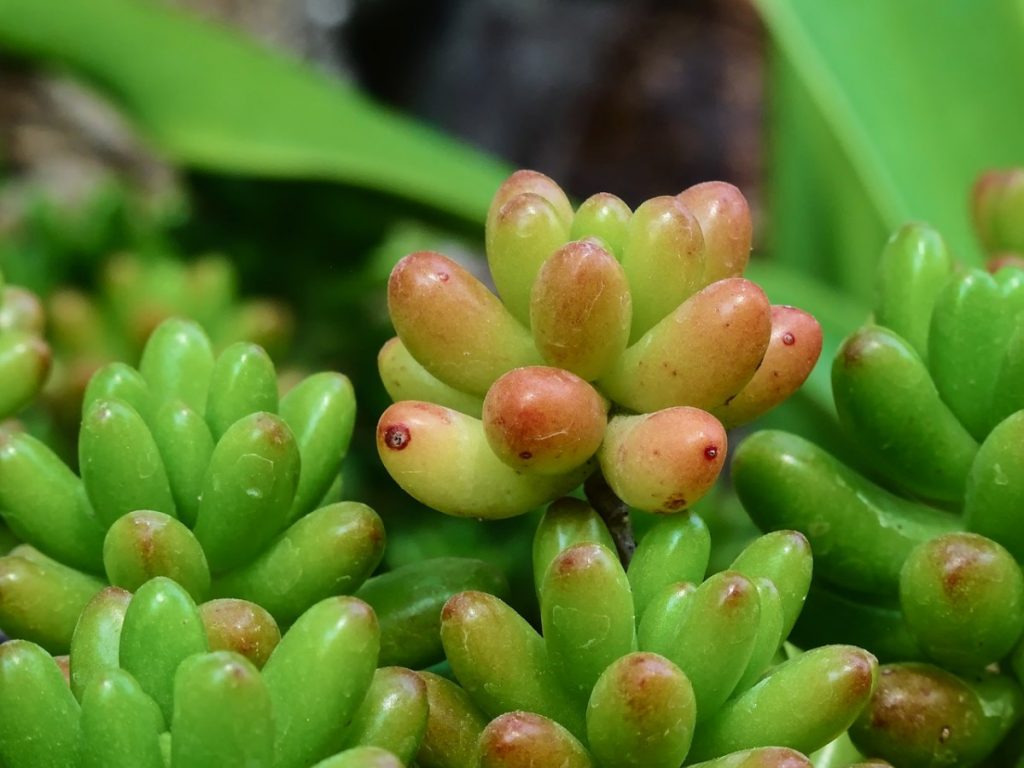
Are Sedums poisonous to cats?
I often receive this question from my readers & followers of this blog, since some of them have several cats at home, and they love them more than they do their plants. The good news is that sedum plants are non-toxic to cats as well. If you have cats and succulents at home, do not worry. Your beloved pets are completely safe in this case.
It is important to remember though that not all succulent plants are safe for animals and humans. Although sedums are non-toxic to dogs and other pets, there are instances when pets accidentally swallowed toxic succulents or plants. If this happens, do not hesitate to consult your pets with a veterinarian.
Symptoms of Poisoning
There are many symptoms of poisoning you might notice with your dogs or other pets. The most common ones are vomiting, diarrhea, tremors or seizures, and stomach upset. If your vet has no idea what plant might have caused the poisoning, you can contact the following experts to help with the clarification of the issue:
- ASPCA Animal Poison Control Center – (888) 426-4435
- Pet Poison Helpline – (855) 764-7661
Final Thoughts
If you have pets and plants at home, your main concern is whether the plants are safe for your pets. Succulents are some of the common indoor plants that are grown indoors nowadays. Not all succulents are safe for pets and humans. Some of them have poisonous substances, and curious pets may come to harm. Luckily though, sedum succulents are safe for dogs, other pets, and humans, including little children.
However, for safety purposes, it is the best idea to keep all your plants away from your pets and kids. Prevention is still better than cure, and at the end of the day, you also do not want to see your dog (or a child) destroying one of your succulents. If you see some symptoms of poisoning, consult a licensed veterinarian in your area.
Is Kalanchoe poisonous to humans?
Who would not love to have some colorful succulents in their house, or in their garden? However, it is important to remember that not all succulents are safe for humans and pets.Kalanchoe is actually one of the plants you have to be careful with, especially if you have curious children running around the house.
To put it as simply as it is, kalanchoe is poisonous to humans and pets. It has a natural-occurring poison that can severely affect the heart. It is similar to digoxin, a common ingredient for heart medications. And just like with many ingredients in medications, if you ingest them in bigger quantities the cure becomes a poison. Hence if you want to be 100% sure to stay safe, I recommend you getting some beautiful hanging planer (for example this porcelain beauty from Amazon), and keeping your Kalanchoes in safe distance from everyone in the house.
How much you ingest determines the impact of the poison in Kalanchoe
The severity of the impact dependens on the amount of the plant you ingest. Of course your body weight also plays a role. When a ten kilo child ingests the same quantity as a hundred kilo adult, the impact will be 10 times higher (speaking in simple terms). Generally speaking, more you eat the greater the danger. The signs of poisoning involve drooling, nausea, vomiting, and abnormal heart rate.
If you have pets indoors, you also need to be careful. The poisonous substance in kalanchoe can also harm your pets such as dogs and cats. I highly recommend that you keep the kalanchoe plants away from children and pets.
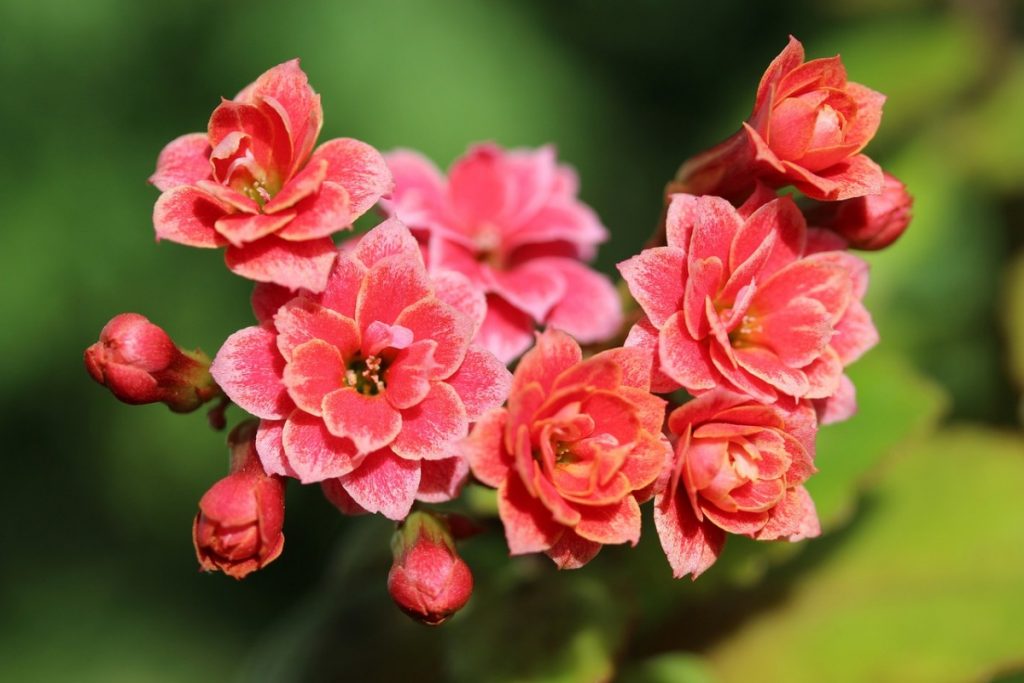
Is it really that poisonous to humans?
Some sources indicate that kalanchoe is poisonous, and if ingested in huge quantities it can even lead to death. However, there are other sources that say kalanchoe is not poisonous to humans, simply because the toxins inside aren’t strong enough to affect us. In my opinion though, with such conflicting opinions, it is better to be safe than sorry with the plant.
What about livestock? Can it eat kalanchoe?
In fact kalanchoe is toxic to many animals due to its cardiac glycosides content. The glycosides have a severe impact on the heart of animals. Cases of livestock deaths have been reported from many areas where this plant grows in free land, and animals grazed on it.
The blossom of kalanchoe has more toxins than any other part of the plant. It explains why there are more incidents of animal poisoning when this plant is in bloom, and animals graze on the flowers.
Is kalanchoe poisonous to dogs and other pets?
Kalanchoe is dangerous to pets for the same reason is is dangerous to cows an sheep. As a rule of a thumb dog (let alone cat) won’t eat the plants. These animals prefer other foods, and unless they are extremely hungry, they won’t opt for attacking and eating the plants.
However, I have read about a few incidents, and the common signs of poisoning were drooling, stomach pain, and diarrhea. In severe cases, cardiac effects are the worst. If this happens to your pet, take it immediately to your vet, so it can have the content of stomach pumped out, and you will at least limit the severeness of the poisoning.
List of succulents poisonous to dogs
Succulents will without a doubt add some beauty to your garden. They add flair and color, shapes and smells, they simply make it a better place. Humans are not the only ones drawn by the succulents’ vibrant colors and unusual features however. Dogs may also want to check them out!
Unfortunately, not all succulents are safe for dogs. Some succulent species are poisonous or even lethal for dogs. And while animals are typically smart with their instincts and won’t eat something that will make them sick, domestic animals do not always share the abilities of their wild counterparts, especially if they aren’t fed a proper diet. That’s why I believe it is better to be safe than sorry, and simply avoid poisonous succulents for dogs. Let’s have a look at some of the most common.
1. Aloe Vera and/or True Aloe
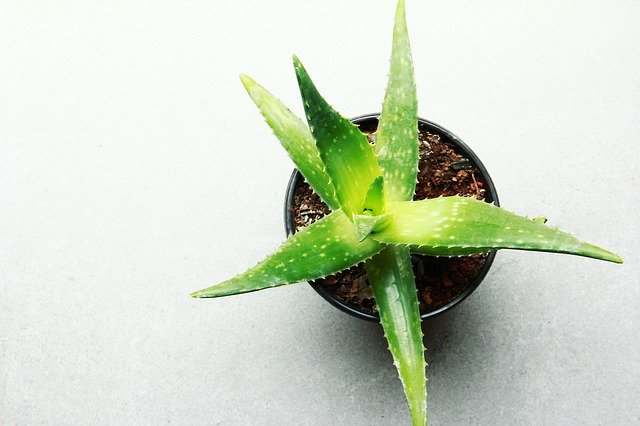
Aloe Vera has dominated the beauty/skincare world for the past few years because of its benefits to the skin. That’s why a lot of people opted to plant it in their garden. But this succulent has properties that are harmful to dogs, the anthraquinones and saponins.
When dogs ingest aloe vera, it can cause abdominal pain, lethargy, nausea, tremors, vomiting, and skin irritation. What’s more, glycosides, anthraquinones, and anthracene are found in true aloe which makes the dog to vomit and change the color of their urine into red.
2. Snake Plant (Sansevieria Trifasciata)

Snake plant is another famous succulent variety. This plant could thrive even when neglected. It could also grow in low-light making it a suitable plant for growing indoors. Snake plant is also known as Mother-in-Law plant.
Behind all its beauty, however lies the hidden danger for the dogs. This succulent contains saponin a substance that if ingested by a dog, it could cause vomiting, nausea, and diarrhea.
* Special tip: Are you into a plant based diet? Why not trying this great plant-based dog food you can get on Amazon for your dog as well, so it can also enjoy the benefits, and does not need to take a bite of your succulent plants :).
3. Euphorbias
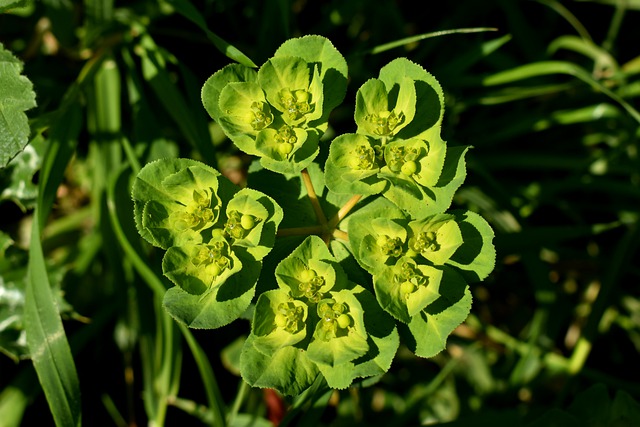
Euphorbias are considered as one of the most unusual and weird-looking succulents. In my personal experience, however, they aren’t difficult to grow. b
They produce latex in their leaves, a white milky sap, which is irritating to humans and dogs. The white sap causes rashes and if ingested by dogs could lead to vomiting and irritation of the mouth and the stomach. Your dog likely won’t die if it eats euphorbias, and for sure it will remember the lesson for the next time, and will avoid the plant. If you want to spare it this unpleasant experience, however, make sure it cannot reach the plant.
4. Kalanchoes
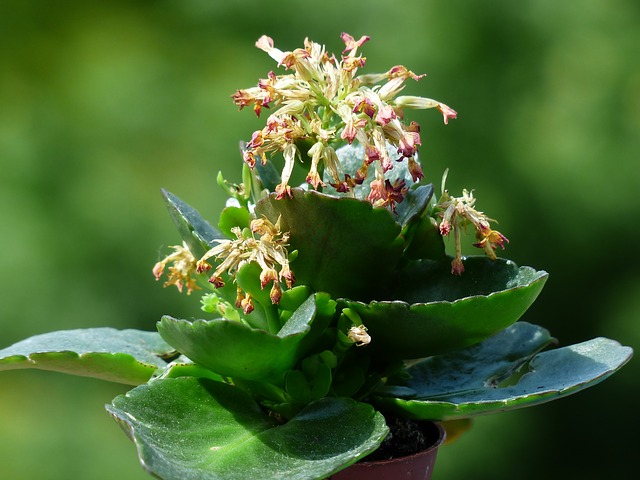
Kalanchoes are pretty popular succulents because of their capability to grow fast and bloom in almost any conditions. They are also common plants, and you can easily find them walking outside, just looking at the gardens. Their color ranges from magenta, pink, red, yellow, up to orange, and it is the variety that makes it a favorite among gardeners.
But these plants are not safe for dogs. One of its downsides is it’s content cardiac glycosides which are pretty harmful to dogs. It causes abdominal pain, lethargy, salivation increase, diarrhea, and may even cause vomiting. If large amount is ingested by a dog, it could be fatal. It will cause elevated heart rate, irregular heartbeats, severe weakness, and labored breathing.
5. Crassula Ovata (Jade Plant)
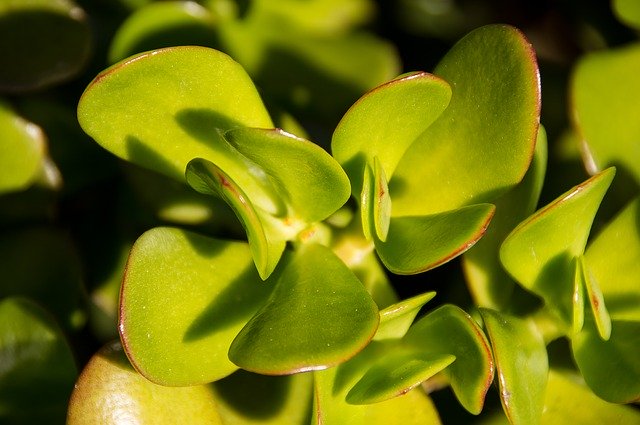
Crassula Ovata is a type of succulent that has smooth, shiny, thick, and fleshy leaves. These leaves would grow in opposite pairs. While it is still unknown why this succulent is poisonous to dogs, if ingested it causes coordination problems, vomiting, lethargy, and even depression.
Sure enough some mysteries of the nature won’t ever be resolved. There’s something about Jade Plant that makes the dogs lethargic and even depressed, but nobody knows what exactly it is. In any case, if you wanted to add a few leaves of your Jade Plant to your dog’s meal for some variety, think twice if this is what you should do.
6. Senecio Rowleyanus (String of Pearls, String of Peas Plant)
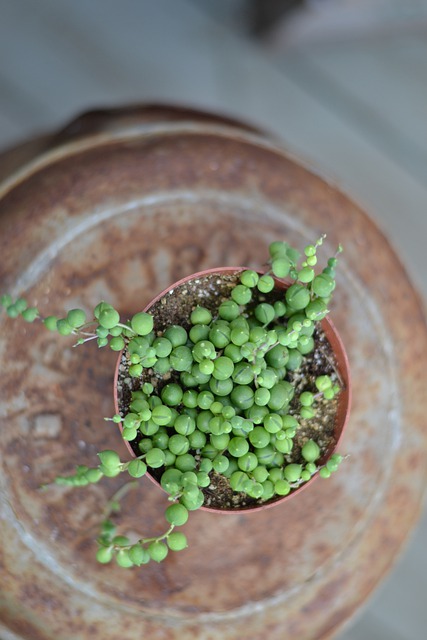
Senecio Rowleyanus has beautiful features, and is one of a kind succulent in my view. The stems of this succulent are covered with round little pea-like leaves. Another thing why most gardeners love to have this succulent in their garden is it produces white and fuzzy flowers that have a cinnamon and vanilla scent in it. It feels almost like a miracle for true plant lovers.
Dogs can mistake this plant for food because of its scent. Unfortunately, when ingested may result in drooling, diarrhea, vomiting, and lethargy. The sap can cause skin irritation and dermatitis to humans and dogs. Hence it is better placing this succulent on a window or somewhere your dog cannot reach it.
7. Sago Palm (Cycas Revoluta)
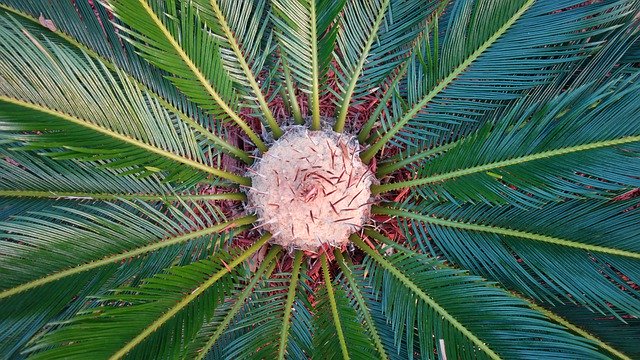 Most people have mistaken sago palm as a palm tree because of its features. But it is actually a succulent. Gardeners love it since it is hardy and can sustain extended periods of drought.
Most people have mistaken sago palm as a palm tree because of its features. But it is actually a succulent. Gardeners love it since it is hardy and can sustain extended periods of drought.
However, sago palms contain the substance called cycasin. When dogs ingest it, it will attack their liver. Cycasin poisoning causes the dogs to vomit, an increase in thirst, and liver failure. These symptoms may occur in the duration of 15 minutes up to a few hours after ingestion. As a rule of a thumb, dogs won’t be attracted to this succulent, and won’t eat it. As they say though you can never be 100% sure, unless you simply decide to not plant it in the space where your dog lives.
9. Panda Plant (Philodendron Bipennfolium)
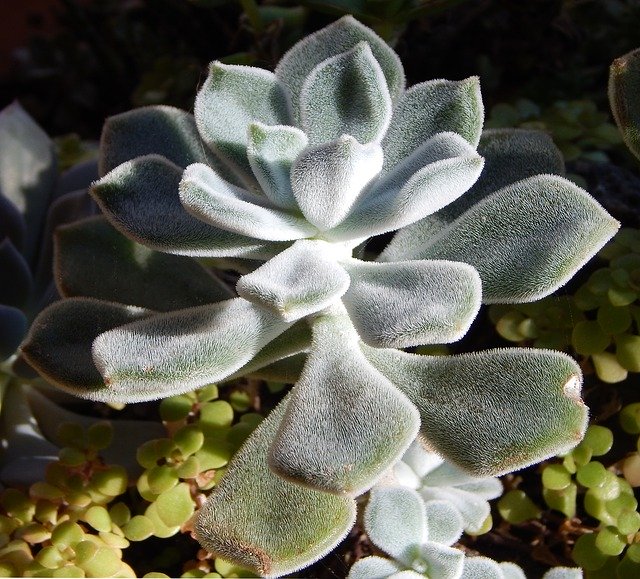
Panda plant is also commonly known as fiddle leaf. This succulent is one of the most common houseplants out there because it only requires easy and little care. This is makes it a good starter plant for beginner gardeners.
However, its leaves contain a type of crystal called insoluble calcium oxalates which can be pretty irritating to the tissues. If ingested by dogs, they would have a hard time swallowing, mouth irritation, and vomiting. In my experience though, dogs do not find this plant attractive at all. They may piss at it to mark their territory, but that’s about it.
10. Kalanchoe Delagoensis (Mother of Millions)
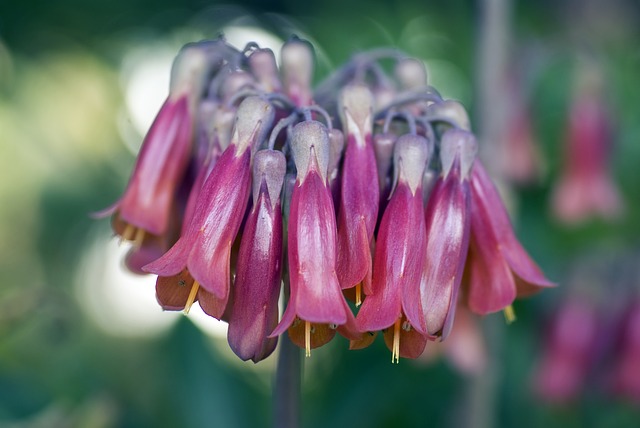
This succulent is also known as Bryophyllum Delagoensis. It is famous for its capability to grow fast, multiply anywhere, and resist drought. Hence the name Mother of Millions. One of its amazing features are the seeds which are capable to survive for years, even when they are pulled out. Once they find favorable conditions, they will simply sprout and a new plant can grow there…
However, Kalanchoe Delagoensis contain a substance called bufadienolide cardiac glycosides. If dogs ingest it in a large amount they would suffer from diarrhea, abnormal heart rhythm, vomiting, and irritation of gastrointestinal tract. In worst cases it can actually lead to death.
Make sure to check for each individual succulent whether it is safe for your dog
Two other popular succulents I’d like to mention here are Crassula Arborescens (Silver Jade Plant) and Kalanchoe Daigremontiana (Mother of Thousands). The first one is known for their silver dollar features leaves. Its leaves are round and the color of the leaves are silvery-green with reddish edges on it. Up to this day, the toxic substance this succulent includes is still unknown. When dogs ingest it, however, they will suffer from nausea and vomit. So there’s definitely something in there which they do not like.
Kalanchoe Daigremontiana on the other hand has a toxic steroid called daigremontianin which causes the dogs to vomit, collapse, have diarrhea, and to some extent abnormal heart rate, tremors, and seizures. Better to keep it out of their reach I would say…
To sum it up, once you have pets at home especially dogs, it is very important to determine the toxicity level of the plants before you purchase them for your garden. Fortunately, many succulent varieties are safe for dogs. Below is the list of pet-friendly or not toxic succulents. You can easily add these succulents to your garden, with no worries of your dog coming to harm.
- Opunta Species
- Aeonium Kiwi
- Sempervivum (Hens and Chickens)
- Burro’s Tail
- Hard Baby Tears
- Painted Lady (Copper Rose, Maroon Plush Plant)
- Haworthia
- Wax Rosette
- Plush Plant
- Christmas Cactus
- Ghost Plant
- Maroon Chenille Plant
- Tree Cactus
- Mexican Snowballs
- Mexican Firecrackers
- Aeonium Arboreum Zwartkop (Black Rose)
- Sedum Morganianum (Donkey’s Tail, Burro’s Tail, Lamb’s Tail)
- Beaucarnea Recurvata (Ponytail Palm Tree)
- Mesembryanthemaceae (Lithops)
- Gasteria
Final thoughts
Though dogs are smart animals and they normally won’t eat something that could cause they harm, incidents of dogs eating poisonous plants (and even dying as a consequence) are not unheard of.
For the peace of mind it is simply better planting succulents that are safe for dogs. Luckily enough, the family of succulents is big, and you have always many choices, even when you decide to limit yourself only to plants that are 100% safe to your pets. I hope you will find such, and wish you happy growing!
Are succulents poisonous to rabbits?
If you have succulents and rabbits at home, you may wonder whether it is a right combination, and whether your beloved pets cannot get sick from eating the plants. Another interesting question is whether your plants won’t die because of your rabbits enjoying their leaves for dinner… There are actually many types of succulents, and some of them are poisonous.
Succulents that fall under the Euphorbia family are succulents that are known for being poisonous, and are the ones you should avoid at all costs, as long as your pets can come into contact with them. They are easy to recognize, however, since they have white sap on their leaves which can irritate human skin, and it can be irritating for animals also. If ingested, it can irritate your stomach and mouth and sometimes may cause vomiting.
Are rabbits safe with these succulents?
Rabbits love to gaze on juicy grasses while they are roaming around their place. The good news is that rabbits usually don’t eat succulents. But if they did, some types of succulent may be poisonous to them.
As a rule of a thumb, you should avoid growing such succulents when you have rabbits. Look, more often than not nothing will happen. But I am sure the last thing you want to think about while on holiday is whether your lovely rabbits aren’t eating your beautiful succulents and harming themselves in the process… Let’s have a look at the succulents that are particularly dangerous.
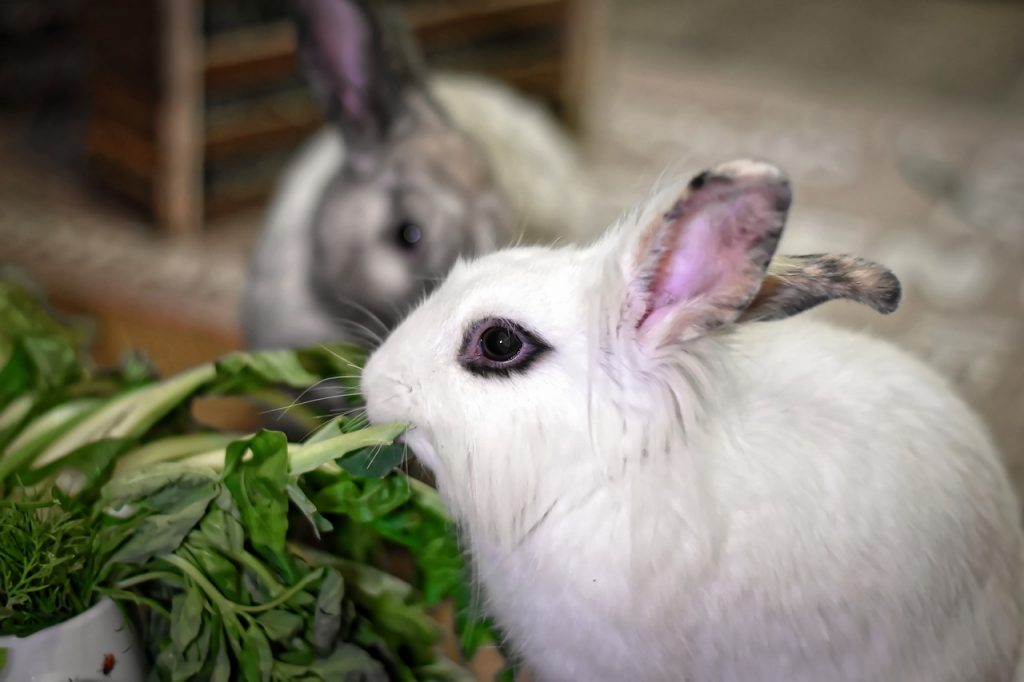
Pencil cactus (Euphorbia)
Pencil cactus is a toxic plant that may cause immediate pain when ingested. This plant is toxic to human beings and to other living organisms because of its milky substance that may lead to gastrointestinal and dermal injury. It is a nice cactus to have at home, but you should consider it twice when you have rabbits, or even children playing around.
Aloe Vera
Aloe Vera as a household plant we often use for medicine, especially in homeopathic remedies. And while it is a beautiful succulent and relatively easy to grow, it should not be given to rabbits to eat. As a rule of a thumb they would not eat it, but if really hungry they may, and it may not end well. .
Rhubarb, Fox Glove – not succulents but plants risky for rabbits
Rhubarb is a common garden plant that many people use for cooking If you’ve never tried rhubarb cake, I definitely encourage you to do so! But you should also know that it contains oxalates that prevent the absorption of calcium. Therefore, rhubarb is harmful to rabbits, but it won’t kill rabbits.
Fox Glove grows often in hedges and woodland. Many people plant it in their gardens though as well, wanting to enjoy its attractive flowers. This plant contains chemicals and substances like cardiac glycosides and is very poisonous. If rabbits eat ti, they may have diarrhea, can be dehydrated, and may feel abdominal pain. Definitely something you should avoid at all costs.
Glycophosate herbicide products, and the impact on rabbits
Many herbicides contain this dangerous chemical compound. Rabbits may be exposed to it anytime they have access to plants/weeds that have been recently treated or sprayed with herbicides. Other ingredients of these products can be poisonous as well.
If rabbits ingested them, they will to become weak and may lose their appetite, which can eventually have fatal consequences. Some develop severe abdominal pain and may have difficulties in breathing. Rabbits that will show these symptoms may die, with or without treatment.
Euphorbia, Jade Plant, and rabbits
Growing succulents from Euphorbia family and having a family of rabbits rabbits at the same time may not be a good idea. Rabbits are attracted to green juicy grasses and they cannot identify if it is poisonous or not, especially if the plant isn’t typical to their natural area, so they do not carry the information in their genes.
If you are going to have such succulents at home, make sure your rabbits cannot reach it. If they do, it will lead them to a life-threatening situation. Jade plant, however, is an excellent succulent to grow when you have rabbits, since it is a “rabbit friendly plant”. It won’t cause any harm to the rabbits, even if they eat it in quantities.
Few tips to make sure your rabbits won’t get poisoned
Rabbits see every plant as food, and may taste any plant they find in their surroundings, whether it is toxic or not. Like succulents, rabbits are cute. But the consequences of having rabbits and succulents at the same time may result in either your pets being harmed, or your beautiful plants being damaged, or eaten altogether… You can do a few things to keep both your pets and succulent plants safe. Let’s have a look at them now.
- Keep your plants out of reach -The best way to do this is to find a safe place for your plants. Rabbits aren’t excellent climbers such as cats, for example. They can jump decently, but it is unlikely that they will reach the plants on your windows, or on your table.
- Place your succulents in different locations – Dividing your plants into several groups may be helpful to avoid harm to your plants. You can do some research about your plants, and divide them into three categories. First, the “non-dangerous” plants, which are completely safe, second, the “non-dangerous” but can cause stomach troubles if eaten, and third, those that are toxic and deadly. Needless to say, you should place them accordingly in your house, masking sure rabbits can reach only plants that are safe to them.
- Decorate the pot – Many bunnies like to dig. Consequently plant pots may not be good for them, because digging in them, they may be exposed to fertilizers. To avoid this, you can put decorative stones in the pot on top of the soil. Once there are stones, the rabbit won’t dig into the soil.
- Giving rabbits a chewing alternative – Same with digging, rabbits are a very curious animal and they will chew anything they see. The good news is that you can buy chewing alternatives at pet shops near you, or get this great organic chewing toys from Amazon (* please note this is a sponsored link, I may earn a few cents at no extra costs to you, if you decide to purchase the toys).
- Train you rabbit – This may sound silly but it is a very nice way to make your furry balls get away from plants. If you put a lot of effort and time to do it and set limits to your bunnies, this may work. Rabbits aren’t stupid as some people think. They can be trained, just like any other pets. But you need to put in the time and effort. Setting limits like telling them “No” when you see them stealing a sniff around your plants at home, may help a lot. You can also try the coins in a jar. If your rabbit approaches succulents, shake the jar to produce a rattling sound. This should discourage them from approaching it again, especially if you repeat it several times.
Which succulents are safe for cats?
Let me share with you now a list of 10 popular succulents that are 100% safe for cats. Of course, many other plants are safe as well, but it would take ages to come up with the complete list. Hence I focused on most popular succulent varieties. Let’s go!
- Echeveria
- Split Rock
- Ice Plant
- Baby Toes
- Haworthia
- Dinteranthus
- Schlumbergera
- Espostoa lanata
- Sedum album
- Ghost Plant
- Hens and Chicks
- Ponytail Palm Tree
- Aeonium ‘Kiwi’
Final thoughts
Buying succulents, you have to consider the pets in your home, and whether the plants are safe for them. If your pets like to lick plants and other objects around them, it is pivotal to buy plants that safe not only for cats but also for dogs, etc.
Most people are fond of cultivating succulents nowadays. There’s nothing wrong with it. But if the same plant that makes you happy jeopardizes the health of your pet, then you need to think twice. In this post, I’ve mentioned several types of succulents that are 100% safe for cats. But the list could have been longer, because we know hundreds of succulent varieties, and I just cannot cover them all here…
Take time to figure out what variety of succulents are safe for your lovely cat. What’s more, consider the cultivation needs of every plant you want to grow indoors or outdoors. Once you carefully consider everything, you will end up with both your plants and animals happy. No doubt that’s the state of affairs you hope to achieve…
* Disclaimer: The content on this page is for general information purposes only. We are pet and plant lovers (and have real life experience with cats and succulents), but we aren’t medical professionals. Hence we make no representations or warranties of any kind, express or implied, about the completeness, accuracy, reliability, suitability or availability with respect to the information contained on this website for any purpose. Any reliance you place on such information is therefore strictly at your own risk. If you aren’t sure, contact a vet or other professional.
May also interest you:
